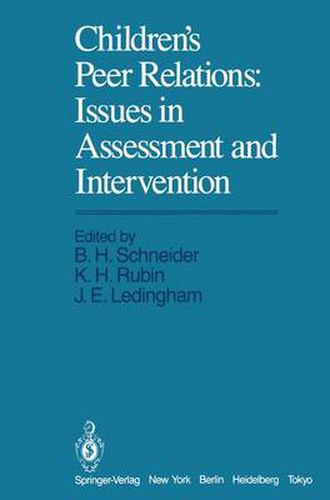Readings Newsletter
Become a Readings Member to make your shopping experience even easier.
Sign in or sign up for free!
You’re not far away from qualifying for FREE standard shipping within Australia
You’ve qualified for FREE standard shipping within Australia
The cart is loading…






This title is printed to order. This book may have been self-published. If so, we cannot guarantee the quality of the content. In the main most books will have gone through the editing process however some may not. We therefore suggest that you be aware of this before ordering this book. If in doubt check either the author or publisher’s details as we are unable to accept any returns unless they are faulty. Please contact us if you have any questions.
Willard W. Hartup This volume amounts to an anniversary collection: It was 50 years ago that Lois Jack (1934) published the findings from what most investigators consider to be the first intervention study in this area. The experiment (later replicated and extended by Marjorie Page, 1936, and Gertrude Chittenden, 1942) concerned ascendant behavior in preschool children, which was defined to include: (a) The pursuit of one’s own purposes against interference and (b) directing the behavior of others. Individual differences in ascendance were assumed to have some stability across time and, hence, to be important in personality development. But ascendance variations were also viewed as a function of the immediate situation. Among the conditions assumed to determine ascendance were the individual’s status in the group as expressed in others’ attitudes toward him, his conception of these attitudes, and his previously formed social habits (Jack, 1934, p. 10). Dr. Jack’s main interest was to show that nonascendant children, identified on the basis of observations in the laboratory with another child, were different from their more ascendant companions in one important respect: They lacked self confidence. And, having demonstrated that, Dr. Jack devised a procedure for teaching the knowledge and skill to nonascendant children that the play materials required. She guessed, correctly, that this training would bring about an increase in the ascendance scores of these children.
$9.00 standard shipping within Australia
FREE standard shipping within Australia for orders over $100.00
Express & International shipping calculated at checkout
This title is printed to order. This book may have been self-published. If so, we cannot guarantee the quality of the content. In the main most books will have gone through the editing process however some may not. We therefore suggest that you be aware of this before ordering this book. If in doubt check either the author or publisher’s details as we are unable to accept any returns unless they are faulty. Please contact us if you have any questions.
Willard W. Hartup This volume amounts to an anniversary collection: It was 50 years ago that Lois Jack (1934) published the findings from what most investigators consider to be the first intervention study in this area. The experiment (later replicated and extended by Marjorie Page, 1936, and Gertrude Chittenden, 1942) concerned ascendant behavior in preschool children, which was defined to include: (a) The pursuit of one’s own purposes against interference and (b) directing the behavior of others. Individual differences in ascendance were assumed to have some stability across time and, hence, to be important in personality development. But ascendance variations were also viewed as a function of the immediate situation. Among the conditions assumed to determine ascendance were the individual’s status in the group as expressed in others’ attitudes toward him, his conception of these attitudes, and his previously formed social habits (Jack, 1934, p. 10). Dr. Jack’s main interest was to show that nonascendant children, identified on the basis of observations in the laboratory with another child, were different from their more ascendant companions in one important respect: They lacked self confidence. And, having demonstrated that, Dr. Jack devised a procedure for teaching the knowledge and skill to nonascendant children that the play materials required. She guessed, correctly, that this training would bring about an increase in the ascendance scores of these children.